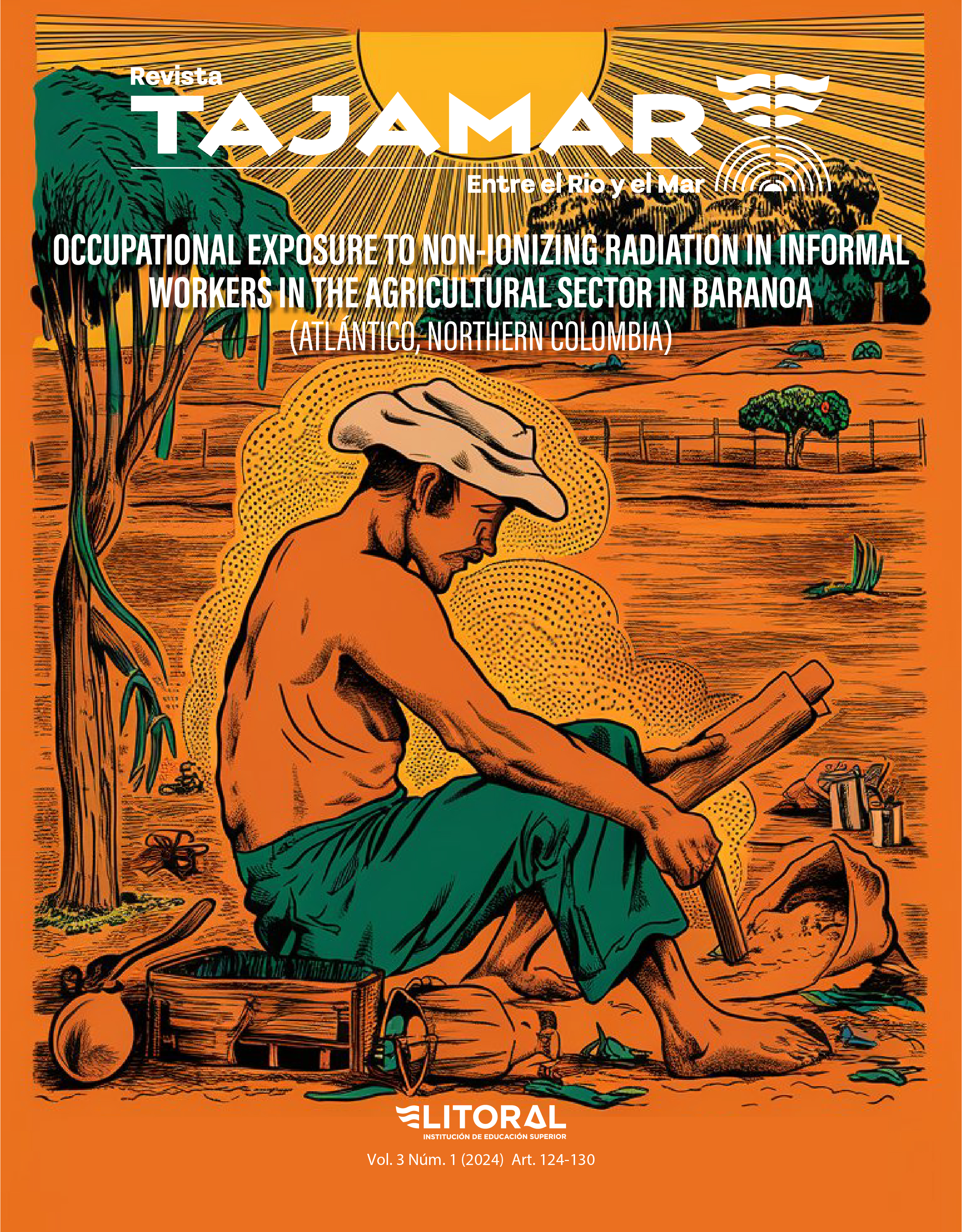OCCUPATIONAL EXPOSURE TO NON-IONIZING RADIATION IN INFORMAL WORKERS IN THE AGRICULTURAL SECTOR IN BARANOA (ATLÁNTICO, NORTHERN COLOMBIA)
Contenido principal del artículo
Resumen
In Colombia, the municipality of Baranoa bases its economy on the agroindustrial sector, but the majority of workers in this sector are informal and the impact of the various occupational risks to which they are exposed, especially the physical risk of non-ionizing radiation, is unknown. that can be generated by activities, especially by prolonged exposure to the sun, for which the main objective of this research is to determine the impact of the physical risk of non-ionizing radiation to which informal workers in the agroindustrial sector in the municipality of Baranoa, Atlántico, in the year 2023, through a quantitative, descriptive approach methodology. cross-sectional design, field study with primary source, where the “Solar UV Radiation Risk Assessment for Outdoor Workers: Operational Review” Questionnaire instrument was applied to a representative sample of 60 informal workers from the agroindustrial sector
of Baranoa, Atlántico. the School of Occupational and Public Health, and the main conclusion is that informal workers in the agroindustrial sector of the municipality of Baranoa have a high risk of non-ionizing radiation when they carry out work related to livestock care, and have a medium risk of radiation. non-ionizing when they carry out the work of collecting cassava and growing vegetables and tubers.
Descargas
Detalles del artículo

Esta obra está bajo una licencia internacional Creative Commons Atribución-NoComercial-SinDerivadas 4.0.
Licencia CC
La revista tajamar utiliza la Licencia Creative Commons:
Atribución-NoComercial-SinDerivadas 4.0 Internacional (CC BY-NC-ND 4.0)
Usted es libre de:
1) Compartir — copiar y redistribuir el material en cualquier medio o formato.
Bajo los siguientes términos:
-
Atribución — Usted debe dar crédito de manera adecuada, brindar un enlace a la licencia, e indicar si se han realizado cambios. Puede hacerlo en cualquier forma razonable, pero no de forma tal que sugiera que usted o su uso tienen el apoyo de la licenciante.
-
NoComercial — Usted no puede hacer uso del material con propósitos comerciales.
-
SinDerivadas — Si remezcla, transforma o crea a partir del material, no podrá distribuir el material modificado.

Citas
Araujo Moncayo, D. A., Capera Tole, A. M., & Plazas Montaña, J. J. (2019). Cáncer en piel por exposición a radiación ultravioleta solar en trabajadores de construcción en el Distrito Capital. Tesis de posgrado, Universidad Distrital Francisco José de Caldas. https://repository.udistrital.edu.co/handle/11349/16285
Araya-Solano, T., Arias-Monge, E., Robles-Ramírez, A., & Villalobos-Rodríguez, A. (2021). Exposición ocupacional a radiaciones ultravioleta UVA/UVB de los trabajadores agrícolas de la provincia de Cartago, Costa Rica. Revista Tecnología En Marcha, 34(1), 104–114. https://doi.org/10.18845/tm.v34i1.4486
Bosch, R., Philips, N., Suárez-Pérez, J. A., Juarranz, A., Devmurari, A., Chalensouk-Khaosaat, J., & González, S. (2015). Mechanisms of photoaging and cutaneous photocarcinogenesis, and photoprotective strategies with phytochemicals. Antioxidants, 4(2), 248–268. https://doi.org/10.3390/antiox4020248
Carrasco, J. (2023). Radiaciones ionizantes y no ionizantes. Aplicación y riesgos. Tesis de pregrado, Hospital Universitario “Virgen de la Victoria” de Málaga, España.
Domínguez, R., Toro, J., Acuña, C., Amaro, S., & Calderón, E. (2023). Exposure to non–ionizing radiation of solar origin: Measurements in Patagonia. https://doi.org/10.54941/ahfe1003066
Glanz, K., Gies, P., O'Riordan, D. L., Elliott, T., Nehl, E., McCarty, F., & Davis, E. (2010). Validity of self-reported solar UVR exposure compared with objectively measured UVR exposure. Cancer Epidemiology, Biomarkers & Prevention, 19(12), 3005–3012. https://doi.org/10.1158/1055-9965.EPI-10-0709
Márquez, R. R., & Camerino, A. A. (2009). Radiaciones no ionizantes. Gestión Práctica de Riesgos Laborales: Integración y Desarrollo de la Gestión de la Prevención, (66), 48–55. https://dialnet.unirioja.es/servlet/articulo?codigo=3090408
Miller, S. A., Hamilton, S. L., Wester, U. G., & Cyr, W. H. (1998). An analysis of UVA emissions from sunlamps and the potential importance for melanoma. Photochemistry and Photobiology, 68(1), 63–70. https://doi.org/10.1111/j.1751-1097.1998.tb03253.x
Ospina Castillo, C. A. (2023). Una aproximación histórica al estudio de la zona habitable a partir de la radiación térmica. (Doctoral dissertation, Universidad Pedagógica Nacional).
Parrales Barreto, H. Y. (2021). Análisis de ondas electromagnéticas no ionizantes y sus efectos en el medio ambiente. (Tesis de pregrado, UNESUM, Jipijapa, Ecuador).
Ramírez Rivera, R. M. (2022). Paisaje y capital socioambiental en el Municipio de Luruaco, departamento del Atlántico, Colombia. (Doctoral dissertation, Universidad de Ciencias Aplicadas y Ambientales).
Salazar, N. (2023). Radiaciones ionizantes y no ionizantes. Tesis de pregrado, Universidad Minuto de Dios, Cali, Valle del Cauca, Colombia.
Saval, S. (2012). Aprovechamiento de residuos agroindustriales: pasado, presente y futuro. BioTecnología, 16(2), 14–46.
Silveira, J. E. P. S., & Pedroso, D. M. M. (2014). UV light and skin aging. Reviews on Environmental Health, 29(3), 243–254.
Tenkate, T. D. (1999). Occupational exposure to ultraviolet radiation: a health risk assessment. Reviews on Environmental Health, 14(4), 187–210.
